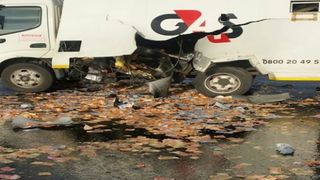
The scene of a botched cash-in-transit robbery in South Africa.
| Pool| NMGNews
Premium
Brazen heists, deadly suburbs and South Africa’s gun violence
What you need to know:
- Frequently, these attacks take place in ambush locations that ensure a slow police response, with some gangs having trained current or former police or army personnel among them.
- Given the frequency and intensity of the attacks, armoured security vehicle operators have this week called on the government of President Cyril Ramaphosa to allow the army to step in, both to supplement the police’s limited manpower, and to help combat the heavily-armed and professionally-trained groups involved
In scenes literally taken from Hollywood movie scripts, South Africa’s notorious cash-in-transit armoured car heist gangs have increased the frequency and intensity of their brazen daylight assaults, triggering calls for the army to step in.
Police are stepping up their efforts to deal with this plague of attacks that often feature commercial explosives, legally used in the mining industry, to blow up armoured vehicles.
Ambush locations
Frequently, these attacks take place in ambush locations that ensure a slow police response, with some gangs having trained current or former police or army personnel among them.
In other cases, heist gangs that have been caught in the act, with intense firefights resulting, have included former military members from neighbouring states, especially Zimbabwe, but also including citizens of Lesotho, Mozambique, and Namibia.
Some incidents have been caught on video by terrified citizens as carloads of heavily armed heist gangsters, numbering up to 20 active shooters, fire automatic assault rifles wildly about, bring armoured cash vans to a halt, keeping guards trapped inside and anyone else on the street under cover, while the armoured vehicle is prepared and then blown up.
Major highways
Other attacks have taken place on major highways, with one incident having gone viral as the security guard in charge dealt with a high-speed attack by gunmen armed with AK-47s, shooting at his van, and then – to the evident surprise of the attackers – the armoured van turning around and charging them down.
There have also been police successes, within one recent incident several armoured car gunmen were shot dead and others wounded and captured, after police crime intelligence led to their hideout in a Johannesburg suburb.
Given the frequency and intensity of the attacks, armoured security vehicle operators have this week called on the government of President Cyril Ramaphosa to allow the army to step in, both to supplement the police’s limited manpower, and to help combat the heavily-armed and professionally-trained groups involved.
These crews do not limit themselves to hits on cash-in-transit (CIT) vehicles, which have armed guards and are tough to get into easily – hence their resort to simply blowing up such vehicles – having also undertaken shopping mall attacks on upmarket jewelry and high-tech shops.
These gangs use stolen luxury models of various high-speed sedans and SUVs for their own transport and in carefully-planned CIT attacks, as well as for sale to associates in neighbouring states.
The highly effective technique of blowing the cash armoured vans up is fast but has the negative effect of often blowing large bundles of cash into the winds, with instances where impoverished local communities have descended onto such a scene to obtain whatever cash has been left by the robbers, and long before the police arrive.
Reported weekly
Several such attacks, or attempts at them, are now being reported weekly.
Police have had some recent successes, taking out two large CIT gangs operating around Johannesburg, after firefights that in each case left several dead and wounded.
While 20 years ago, when this phenomenon moved from the movie screens – as seen in the Hollywood hit Heat, starring Robert De Niro and Al Pacino – to the streets, with techniques and methods shown in that movie used in a literal copycat real-life attack at least once, and when there were one or two such gangs operating in greater Johannesburg, there are now many similar gangs in various urban centres.
One incident on Saturday this past weekend was ongoing for over 30 minutes, and ended with the cash-enriched robbers fleeing, before any onsite reaction force’s arrival or police to be seen.
Cash-in-transit sector operators responded to that event by calling for the army to step in, saying police were overwhelmed and outgunned.
A well-known citizen crime-fighting figure, with his own TV show on the subject, Yusuf Abramjee, blames several factors for the surge not only in CIT attacks but all forms of gun violence, on the easy availability of many thousands of illegal guns at large.
Illegal guns
Cape Town’s Mayoral Committee Member for Safety and Security J P Smith blamed much of the wider issue of many illegal guns, such as are used in CIT and other armed robbery attacks, being available on slackness by the South African Police Service (SAPS) in ensuring that police guns are not entering the illegal market, along with previously seized weapons being resold by corrupt officers.
Smith said the SAPS was itself responsible for “over 9,000 weapons” of its own, or which had been previously seized, finding their way back into the illegal market.
Individual police officers, often off-duty, have been repeatedly targeted by gangsters with the specific purpose of stealing the wounded or dead officers’ official firearms.
At least two police stations in remote areas have been raided by groups of armed persons who have then seized all weapons from on-duty officers, and any in strongrooms or lockers, which are forced open by such raiding parties whose prime target was the weapons housed in these police stations.
During the ‘failed uprising’ of mid-2021, following the jailing of former president Jacob Zuma, numerous gun shops were targetted and cleaned out, with many hundreds of weapons from those sources also entering the local and regional illicit arms trade, some automatic assault rifles finding their way into CIT gang use.
By far the greatest number of such weapons in the underground market come from formerly confiscated weapons, however.
The corruption within the police which leads to seized illegal weapons finding their way back onto the street runs from top to bottom, with the former Head of Gauteng's firearm licencing division, Colonel Chris Prinsloo, sentenced to 18 years behind bars in June.
Prinsloo, 55, who had 35 years’ experience in the force, was found in trial to be part of a group of criminals who stole guns and ammunition destined for destruction, and resold them, primarily to gangs in Johannesburg and Cape Town’s notoriously dangerous and gang-infested eastern suburbs collective dubbed the Cape Flats.
Prinsloo oversaw the armoury from which the weapons he sold had been stolen.
It was alleged that he sold at least 2,400 firearms, mainly to known gangsters, between 2007 and 2015, along with his co-accused, a National Heritage Act inspector of firearms, together earning from their illicit operation around $100,000.
Many of the weapons that should have been destroyed but we resold into underground hands have been subsequently used in armed robberies of various kinds.
Beyond wild shootouts between CIT robbers and police, the illegal guns plague fuels constant gang turf wars, with two recent incidents highlighting the daily dangers for citizens, one involving 12-year-old Janna Fourie who was killed by warring gangsters near her home in Westbury, Johannesburg, on an early Friday evening in June.
The other incident involved an unnamed 15-year-old girl, also gunned down apparently in gang cross-fire this past weekend in Westbury.
The hysterical mother of the slain 15-year-old wailed at the site of her daughter’s killing: “Every day, every hour, every minute, there is gunfire. We cannot live like this anymore.”
Lt-Gen Shadrack Sibya, head of SAPS crime intelligence, asked after the latest round of CIT attacks whether the police were winning or losing their battle against these very violent groups, said he could not agree that police were ‘losing’.
“We have seen police successes – out of 43 cases (of armed robbery by gangs), arresting up to 80 people, and of those related to CIT specifically, we have arrested 51 in 15 cases.
“So, we do respond to CIT attacks. Unfortunately, crime is there, and we cannot stop all crime 100 percent – there is crime in every country.”





